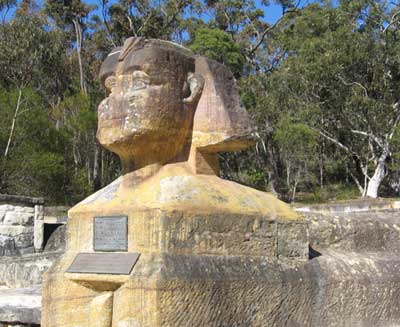When I was a child, my family often used to go for picnics on a Sunday. After Sunday school, my father would have the car ready, my mother would have the sandwiches made and the drinks packed, and we would head off to some interesting part of Sydney.
My brother and I always enjoyed these picnics. Regular places visited were mostly on the northern side of the harbour. They included French’s Forest, the picturesque Church Point, Bobbin Head and the charmingly named Coal and Candle Creek, the latter two destinations in the Ku-ring-gai Chase National Park.
A few years ago I remembered our family visiting, on a number of occasions, a miniature sandstone sphinx and two pyramids on the way home from our picnics. From memory I pictured them being somewhere away from the main road in a bushland setting. I also associated a feeling of solemnity with these visits. I did a bit of ‘googling’ and found that these unusually placed Egyptian replicas were located just inside Ku-ring-gai Chase National Park, not very far from Lady Davidson Home. The stone works were crafted by a returned World War 1 soldier named Private William Thomas Shirley.
Private Shirley joined the Australian Imperial Force on 11 January 1916. He was 39 years old. Born in the Lake District in the north west of England, he was by trade, a stonemason and builder. Before coming to Australia he had completed a five year apprenticeship in Liverpool.
He enlisted at Casula, a south western suburb of Sydney. His enlistment papers record that his hair was grey, his complexion was dark, he weighed 60.8 kg (134 lb) and his height was 1m 68cm (5 ft 6 in). Before he sailed in May 1916 from Sydney on HMAT A46 Clan Mac Gillivray for overseas service, he was fined for being absent without leave at least three times.
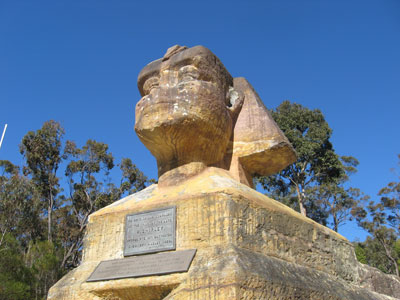
He enlisted at Casula, a south western suburb of Sydney. His enlistment papers record that his hair was grey, his complexion was dark, he weighed 60.8 kg (134 lb) and his height was 1m 68cm (5 ft 6 in). Before he sailed in May 1916 from Sydney on HMAT A46 Clan Mac Gillivray for overseas service, he was fined for being absent without leave at least three times.
He served as a private in the 13th Battalion in the trench warfare on the Western Front in France at Pozieres, in August and September. He would have experienced the heavy German shelling and seen many of his comrades killed and injured. On 11 April, 1917 his battalion was involved in the first battle of Bullecourt. Three days later he was evacuated to Rouen suffering debility.
On 25 April he was shipped to a hospital in London where he developed pleurisy, most probably caused by gassing. In May his next of kin were advised by mail that he was in the Southwark Military Hospital suffering mild pleurisy. On 7 June he was transferred to the 2nd Australian Auxiliary Hospital in Southall still suffering from pleurisy. On his discharge from there on 26 June, he went absent without leave. Two days later he was fined two days’ pay and again admitted to hospital with pleurisy.
It was believed that he had been suffering from this condition prior to his enlistment but it was acknowledged that his active service had accentuated it. After some bureaucratic indecision, on 1 August he was assessed as permanently unfit for both general and home service. He returned to Australia in October 1917 suffering senility and debility. He spent a further time in hospital and was discharged in November with a fortnightly pension of 15 shillings. In August 1922 he received the Victory medal, Star medal and British war medal.
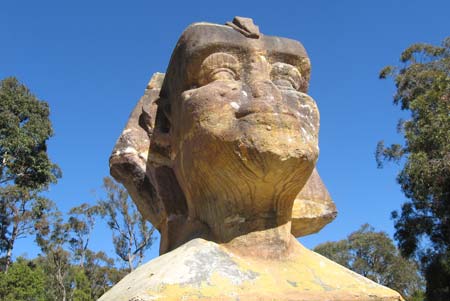
In 1924 Shirley became one of the 85 patients at Lady Davidson Home, a hospital residence for those suffering from tuberculosis. A Sydney Morning Herald reporter who visited there in June that year found it confronting, reminding his readers that for many WW1 soldiers “the war is still a grim reality”. However, he left with an inspiring story about one patient there, William Shirley. As part of an occupational therapy program, the reporter told how Shirley began enthusiastically carving a sphinx out of a rock in the nearby bushland. Using chisels, hammers and a mallet, Shirley had been working on his replica of the giant Egyptian sphinx at Giza for about nine or ten weeks and was “far from finished”. He intended eventually to age the newly worked sandstone by colouring it, thereby allowing his work to blend more naturally into the landscape.
Despite working only a couple of hours a day, Shirley’s health further suffered. In fact, the day that the reporter visited the Home he was unable to speak to Shirley who was bedridden. However, a Herald colleague had spoken to him the previous day and he quoted some of what Shirley had said in his newspaper article.
“I have just been filling in my spare time … I did not know that anybody outside the hospital knew what I was doing. One has to do something, though, and this work appeals to me.”
The 4th Infantry Brigade, of which Shirley’s 13th Battalion was a sub-unit, had been based originally in Egypt. His sandstone sphinx and pyramids were to serve as a memorial to those soldiers, his ‘glorious comrades’ of the Australian Imperial Force and all those who did not return from the battle fields. But Shirley’s memorial also validates the death of those who, like Shirley himself , died or would later die as a result of injuries caused by their war service. The inclusive quality of this unique memorial has obviously endeared it to the public over the years.
In his book Sacred Places, K.S.Inglis states: “The making of Great War memorials in Australia was a quest for the right way, materially and spiritually, to honour the soldiers.”
Shirley successfully accomplished this “quest” without the aid of committees, fundraising or divisive debate. Commenced as a project to help repatriate a broken soldier, it took a new direction as Shirley realized the potential for his sphinx and pyramids to become a memorial.
He worked in a beautiful, bushland setting where consideration of the memorial’s prominence or accessibility would not have concerned him. Over the years, the seclusion, serenity and quiet of the memorial’s location would provide visitors with a place for contemplation and acknowledgement of the service and sacrifice of the A.I.F. soldiers. Shirley’s memorial shines a modest light on the horrific, violent and impersonal nature of warfare and gives us cause for serious reflection. He thus created a special space for generations to come.
A few years ago I purchased a small book of poems entitled “Memories in Verse” by Percy Dixon. The anthology was published in 1972. I was pleasantly surprised to come upon Dixon’s poem Little Egypt, a simple, sincere homage to Private Shirley and his stone carvings.
“…Along a byway lonely,
I contemplate today.”“Twas here that Private Shirley
Had carved immortal links
In rock, and parted early
From pyramids and sphinx.”
Dixon’s poem also includes a moving reference to Lady Davidson Home and its bushland setting.
“A Soldier’s Home his dwelling
Sad legacy of war;
‘Midst wild flow’rs ever telling,
How sweet life was before.”
The poem suggests that Shirley’s stone creations came at considerable cost to his health. During their construction, he was “growing weaker”. Sadly Private Shirley only survived another couple of years, dying on 27 August 1929. The poem also includes a poignant reference to Lady Davidson Home and its bushland setting.
“A Soldier’s Home his dwelling
Sad legacy of war;
‘Midst wild flow’rs ever telling,
How sweet life was before.”
During World War 2 my mother joined the Voluntary Aid Detachment, receiving first aid training from the St John Ambulance Association to work in hospitals and convalescent homes like Lady Davidson Home. Perhaps she spent some time at this hospital during the war and this accounted for our visits to such a special place.
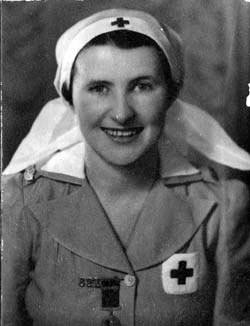
Dixon’s poem also refers to the severe strain that the stone creations placed on Shirley’s health. During their construction, he was “growing weaker”. Sadly Private Shirley only survived another couple of years. In August 1929 he was living at Davistown on the central coast. He became very ill and died shortly after being admitted to the Randwick Military Hospital. on 27 August. He was buried in the Roman Catholic section at Rookwood.
I sometimes wonder whether Private Shirley ever returned, after his discharge from Lady Davidson Home, to visit and/or work on the memorial. Most likely his poor health would have prevented this. Reports suggest that he worked, when his health allowed, for around eighteen months on the sphinx. He also built two pyramids on either side of the sphinx. Apparently these pyramids were funded with money donated by a woman from Newcastle. (The Queenslander, 8 September 1937)
Two years after his death, Shirley’s war memorial was officially dedicated. In 1930 the Tuberculosis Sailors’ and Soldiers’ Association of NSW had been given responsibility for his carvings. A fortnight before the ceremony, members of the Association completed the building of paths and a retaining wall. While so employed, the workmen uncovered a natural spring. This became a wishing well where visitors could place coins.
On Sunday 3 May 1931, the NSW Governor, Sir Phillip Game, unveiled the sphinx in front of a large crowd, one report estimating it to be about 2000 people. Remembering these were still Depression days, Shirley’s story must have been an inspiration for many in the crowd. At the same time another significant construction, admittedly more intrusive upon the landscape, was taking shape in the form of a giant, grey arch over Sydney Harbour. Sir Phillip Game, in his official capacity, would also attend the opening of that one the following year.
The Sydney Morning Herald on 4 May 1931 described Shirley’s memorial as “a truly remarkable war memorial”. When reporting on the Governor’s speech, they made mention of his reference to the significance of the sphinx, saying it “was supposed to be a symbol of intellect and force or of the resurrection. Whichever was right, both were applicable to war memorials. It was intellect and force of character which carried the A.I.F. men over half the world, and finally to victory. The same qualities would enable them in these days to bring into being the ideals for which they had fought. If it was a symbol of resurrection, it would be a resurrection of peace and human concord throughout the world.”
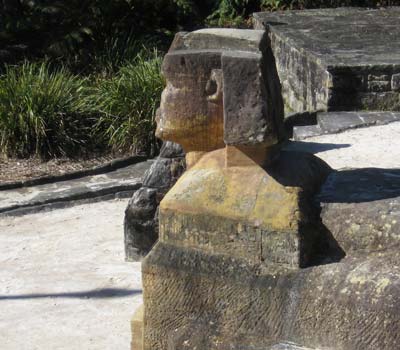
The following year, the TB Sailors’ and Soldiers’ Association gathered again at the sphinx memorial to hear an address by Rev Knox of Chatswood enthusiastically claiming that the memorial was “a tribute to the sons of Australia who, seventeen years ago, had given their blood in proclamation to the world that Australia was a nation”. Shirley’s memorial to his “glorious comrades of the A.I.F.” was becoming part of a new story about war.
Pilgrimages to the sphinx continued each year. In 1933 Mr H.C. Durant, a pilot who served with the Royal Air Force, began a tradition of flying over the area before the start of the ceremony and dropping a wreath as close as possible to the sphinx. The Sydney Morning Herald reported in April 1936 that a crowd of 2000 had attended that year’s ceremony. Part of the crowd included many residents from Lady Davidson Home. In the official address, Shirley’s “fortitude and patience” were compared to “the spirit shown by the Anzacs”.
In the early1990s the State government carried out restoration work on the memorial. It was rededicated on 9 November 1995.
A poignant postscript can be added to the engaging story of Private Shirley. On the second anniversary of Shirley’s death, the following dedication appeared in the Sydney Morning Herald, 27 August 1931.
“In loving memory of my dear friend …
‘There’s someone who misses you sadly,
And thinks of you day by day.
But we’ll meet again, dear Will,
At the dawn of a beautiful day.’
Inserted by his loving friend, Emma Flanegan.”
The following verse appeared in the Sydney Morning Herald, 27 August 1932. It was again inserted by ‘his loving friend’, Emma Flanegan.
“Years cannot alter my fond love for you,
For your voice and your smile I crave,
Your memory will live my whole life through,
As you lie in your silent grave.”
© Jim Low
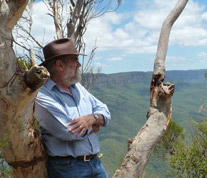
Jim Low is a singer/songwriter and published author.
His background is in education and he has also developed learning materials for the NSW Department of School Education. His passion is Australian history.
EMAIL: jim@jimlow.net WEBSITE: jimlow.net


